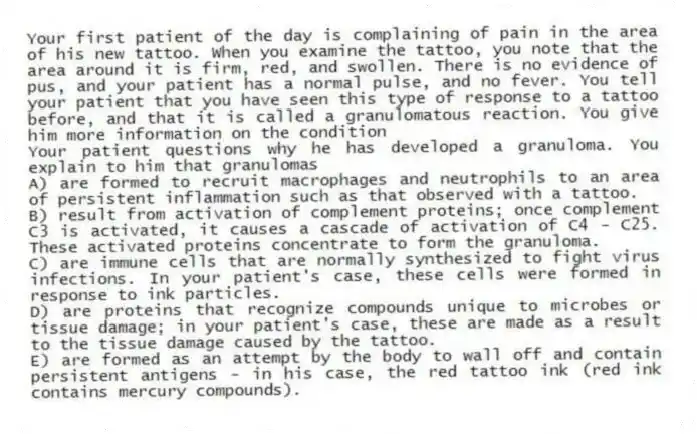
Your first patient of the day is complaining of pain in the area of his new tattoo. When you examine the tattoo, you note that the area around it is firm, red, and swollen. There is no evidence of pus, and your patient has a normal pulse, and no fever. You tell your patient that you have seen this type of response to a tattoo before, and that it is called a granulomatous reaction. You give him more information on the condition
-Your patient questions why he has developed a granuloma. You explain to him that granulomas
A) are formed to recruit macrophages and neutrophils to an area of persistent inflammation such as that observed with a tattoo.
B) result from activation of complement proteins; once complement C3 is activated, it causes a cascade of activation of C4 - C25. These activated proteins concentrate to form the granuloma.
C) are immune cells that are normally synthesized to fight virus infections. In your patient's case, these cells were formed in response to ink particles.
D) are proteins that recognize compounds unique to microbes or tissue damage; in your patient's case, these are made as a result to the tissue damage caused by the tattoo.
E) are formed as an attempt by the body to wall off and contain persistent antigens - in his case, the red tattoo ink (red ink contains mercury compounds) .
Correct Answer:
Verified
Q81: Which of the following is NOT a
Q82: Your first patient of the day is
Q83: Which of the following is NOT True
Q84: Your first patient of the day is
Q85: Your first patient of the day is
Q87: Your first patient of the day is
Q88: When microbes are introduced into normally sterile
Q89: Which of the following do you think
Q90: Given the name "leukocyte adhesion deficiency," which
Q91: Given what you understand about inflammation, why
Unlock this Answer For Free Now!
View this answer and more for free by performing one of the following actions

Scan the QR code to install the App and get 2 free unlocks

Unlock quizzes for free by uploading documents